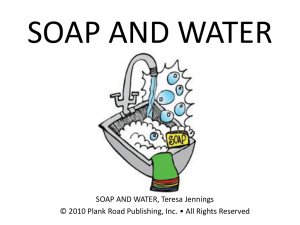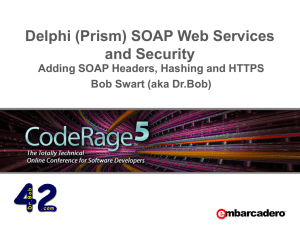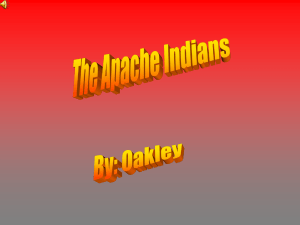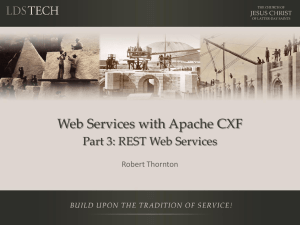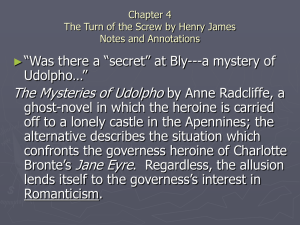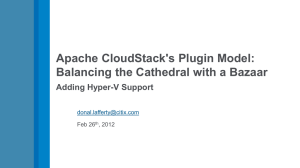CXF-Training-Part
advertisement
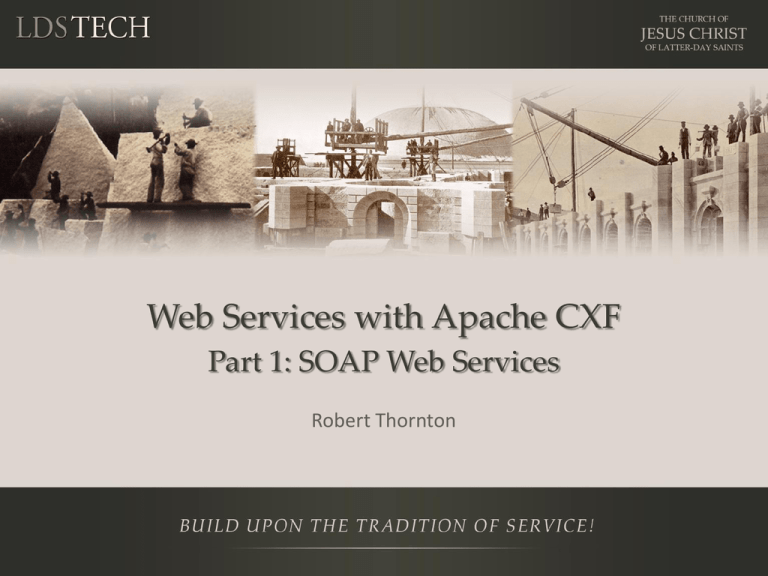
Web Services with Apache CXF
Part 1: SOAP Web Services
Robert Thornton
Notes
•
•
•
•
•
This is a training, NOT a presentation
Please ask questions
This is being recorded
https://tech.lds.org/wiki/Java_Stack_Training
Prerequisites
– Maven
– Spring
– Web Application Development
Objectives
At the end of this presentation, the participant will be able to:
• Describe the role of Apache CXF in building SOAP web services.
• Understand the basic characteristics and terminology of a SOAP
web service.
• Describe the pros and cons of SOAP vs. REST.
• Use Apache CXF and Spring to produce a SOAP HTTP endpoint in
a Java web application.
• Be able to consume a SOAP HTTP web service within an
integration test.
• Be able to identify the purpose and components of a SOAP WSDL
document.
Apache CXF: What is it?
What is Apache CXF and what does it provide?
• An open-source web services framework
• Support for web service standards and JSR APIs.
• Tooling and configuration for building and
consuming web services using the JAX-WS and
JAX-RS frontend APIs.
• Spring namespace handlers for integration with
the Spring Application Framework.
Apache CXF: A Robust Framework
Apache CXF provides robust support for producing and consuming
web services:
• JSR APIs: JAX-WS, JAX-RS, JSR-181 annotations, SAAJ
• WS-* specifications for web service interoperability.
• A variety of message transports, protocol bindings, data bindings,
and formats.
• Flexible, lightweight deployment in a variety of web application
containers or stand-alone.
• Tooling for code and WSDL generation and validation.
• Multiple language support.
Apache CXF: Help, I’m drowning!
With all these features, how do I choose?
Apache CXF: Recommendations
The Java Stack recommends the following two
basic feature sets for using CXF to produce and
consume web services in Java applications:
• Option #1: JAX-WS, using the SOAP protocol over
HTTP transport with JAXB data binding.
• Option #2: JAX-RS using REST over HTTP with
JAXB, XML, or JSON data binding.
This training will focus on producing and consuming SOAP web services
with JAX-WS. A future training session will cover JAX-RS.
Apache CXF: Still too many choices?
Apache CXF allows JAX-WS with SOAP and JAX-RS
(REST) to be used side by side.
But which is right for my project?
SOAP vs. REST: An Overview
Both SOAP and REST are front-end technologies. That is, their
services are exposed within the view layer of an application.
SOAP
• Supports a variety of transports (HTTP, JMS, etc.)
• Integrates with a variety of web service standards.
• Typically used to pass contractually structured data between
applications.
REST
• Simple point-to-point communication using well-established HTTP
verbs, protocols, and standards.
• Often used to faciliate dynamic HTML page creation.
SOAP: Pros and Cons
Pros:
• Agnostic to language, platform, and transport.
• Designed for distributed environments and applications.
• Richer, more mature, standards-based support and integration.
• Built-in error-handling (faults).
• Extensible through integration with other transports and data
bindings.
Cons:
• Heavier abstraction and steep learning curve.
• More verbose.
• Difficult to develop without tools.
REST: Pros and Cons
Pros:
•
•
•
•
Agnostic to language and platform.
Conceptually simpler to understand and develop.
Less reliance on tools
Closer in design and philosophy to the web.
Cons:
• Locked into the HTTP transport model. Cannot be scaled to non-HTTP
communication models.
• Lack of standards support for security, policy, messaging, etc., making
apps with richer requirements harder to develop.
* For a more detailed comparison of SOAP and REST, see the following excellent
article: http://ajaxonomy.com/2008/xml/web-services-part-1-soap-vs-rest or
perform an internet search on “SOAP vs REST”.
SOAP vs. REST: Summary
• Know your deployment environment and
infrastructure.
– Will your service be distributed?
– Will communication need to pass through non-HTTP
boundaries?
• Know your interoperability and scalability
requirements.
– Who will be consuming your service?
– Will you need to support non-HTTP transports (e.g.
JMS, SMTP, POP3) now or in the future?
And now for a song….
Oh, I wish I were a little bar of …
SOAP!
JAX-WS and SOAP
Essential Terminology:
• WSDL
• Web Service Namespace URI
• Endpoint URL or Port
• Service Endpoint Interface (SEI)
• Operation
• Message
• Envelope
JAX-WS: Defining a Service Endpoint
The JAX-WS specification uses Java annotations to
define your web service endpoint.
• CXF processes these annotations to produce your
WSDL
• The annotations can be used to customize many
aspects of how your WSDL and web service
schema are published.
JAX-WS: Annotations
@javax.jws.WebService
• Marks a Java interface as a Service Endpoint Interface.
• Marks a Java class as a web service endpoint implementation.
@javax.jws.WebMethod
• Optional annotation for customizing a SOAP web service operation
@javax.jws.WebParam
• Optional annotation for customizing the mapping of an individual parameter
to a web service message part, or input parameter.
@javax.jws.WebResult
• Optional annotation for customizing how SOAP treats the output of a web
operation.
JAX-WS: More Annotations
@javax.jws.soap.SOAPBinding
• Customizes the mapping of the web service onto
the SOAP message protocol.
• Its use is optional as the default settings are the
recommended values and will make your web
service the most portable.
JAX-WS: Defining a Service Endpoint
A Basic Example:
package org.lds.training.cxf.labs.ws;
import java.util.List;
import javax.jws.*;
// General web service annotations
import javax.jws.soap.*; // SOAP-specific WS annotations
@SOAPBinding(
style = SOAPBinding.Style.DOCUMENT,
use = SOAPBinding.Use.LITERAL,
parameterStyle = SOAPBinding.ParameterStyle.WRAPPED)
@WebService(
targetNamespace = "http://schema.lds.org/cxf-labs/user/v1.0")
public interface UserService {
@WebMethod(action = "CreateExample")
public User getUser(@WebParam(name = "username") String username);
}
Web Services on the Java Stack
A Java Stack web service provider typically consists of the
following Maven projects:
• A parent (POM) module
• An API (JAR) module
– This is where you should define your web service interface.
• A web application (WAR) module
– This is where you implement your web service functionality
• A QA module
– This is where your integration tests will consume your web
service during development and testing.
• A deployment module
Apache CXF: SOAP: Lab 1
Lab 1: An Example SOAP Web Service
http://tech.lds.org/wiki/Web_Services_with_Apache_CXF_-_Part_1
Namespace Handlers
For Spring bean configuration, the Java Stack
defines two namespace handlers for JAX-WS web
services:
• <stack-ws:produce/>
– Used in the web application to configure the JAX-WS
web service bean.
• <stack-ws:consume/>
– Used in a QA module or other application to
configure a JAX-WS client proxy bean.
Configuring a Web Service Provider
Attributes to <stack-ws:produce/>
• implementor
– The bean name of the endpoint implementation class
• secured
– Whether to secure the web service with LDS Account.
• address
– The endpoint address where the service will be published.
• authentication-manager-ref
– allows customization of the authentication manager
Configuring a Web Service Client
Attributes to <stack-ws:consume/>
• service-class
– The bean name of the endpoint implementation class.
• endpoint
– The published endpoint service address.
• user, password, password-type
– For user authentication. Both plain text and digest passwords are
supported.
• wam-authenticator, wam-cookie-resolver-ref
– Provides authentication through WAM
• ssl-trust-server
– Specifies whether the server’s SSL cert should be automatically trusted.
Apache CXF: SOAP: Lab 2
Lab 2: Producing a SOAP Web Service
http://tech.lds.org/wiki/Web_Services_with_Apache_CXF_-_Part_1
Apache CXF: SOAP: Lab 3
Lab 3: Consuming a SOAP Web Service
http://tech.lds.org/wiki/Web_Services_with_Apache_CXF_-_Part_1
Resources
On the web:
• http://cxf.apache.org
• http://www.w3.org/TR/soap/
• http://en.wikipedia.org/wiki/Cxf
• http://en.wikipedia.org/wiki/SOAP
• http://ajaxonomy.com/2008/xml/web-services-part-1-soap-vsrest
In Print:
• Developing Web Services with Apache CXF and Axis 2, Kent Kai Iok
Tong, TipTech Development, 2005-2010. ISBN: 978-0-557-25432-3
